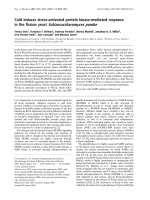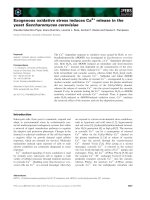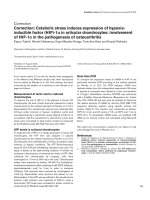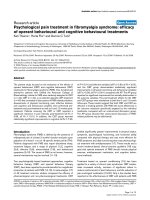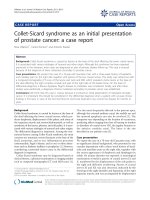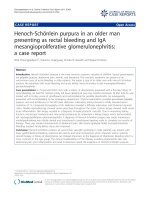Báo cáo y học: "Hepatic oxidative stress in an animal model of sleep apnoea: effects of different duration of exposure" potx
Bạn đang xem bản rút gọn của tài liệu. Xem và tải ngay bản đầy đủ của tài liệu tại đây (1.34 MB, 7 trang )
RESEARCH Open Access
Hepatic oxidative stress in an animal model
of sleep apnoea: effects of different duration
of exposure
Darlan P Rosa
1*
, Denis Martinez
1
, Jaqueline N Picada
2
, Juliane G Semedo
2
and Norma P Marroni
1,2
Abstract
Background: Repeated apnoea events cause intermittent hypoxia (IH), which alters the function of various systems
and produces free radicals and oxidative stress.
Methods: We investigated hepatic oxidative stress in adult mice subjected to intermittent hypoxia, simulating
sleep apnoea. Three groups were submitted to 21 days of IH (IH-21), 35 days of IH (IH-35), or 35 days of sham IH.
We assessed the oxidative damage to lipids by TBARS and to DNA by comet assay; hepatic tissue inflammation
was ass essed in HE-stained slides. Antioxidants were gauged by catalase, superoxide dismutase, glutathione
peroxidase activity and by total glutathione.
Results: After IH-21, no significant change was observed in hepatic oxidative stress. After IH-35, significant
oxidative stress, lipid peroxidation, DNA damage and reduction of endogenous antioxidants were detected.
Conclusions: In an animal model of sleep apnoea, intermittent hypoxia causes liver damage due to oxidative
stress after 35 days, but not after 21 days.
Background
In obstructive sleep apnoea (OSA), pharyngeal occlusion
occurs, typically for 10 to 40 seconds, causing a decrease
of PaO
2
and an increase in PaCO
2
, ending with an arou-
sal [1]. Intermittent hypoxia due to OSA causes oxida-
tive stress, a recognized mechanis m in the nonalco holic
fatty liver disease (NAFLD), which may progress to non-
alcoholic steatohepatitis (NASH) [2].
Intermittent hypoxia (IH) increases liver damage [3].
During hypoxia, activation of xanthine oxidase [4],
NAPDH oxidase [5], and phospholipase A
2
[6] occurs,
forming reactive oxygen species (ROS). Increased ROS
and decreased antioxidant capacity [7-9] induce oxida-
tive stress [10]. In hypoxia, superoxide anions are
formed, which, together with nitric oxide (NO), the
main vasodilator, produce peroxynitrite [11-13]. This
reaction reduces the bioavailability of NO, attenuating
NO-dependent vasodilation, capillary perfusion and
expression of adhesion molecules [14-17].
The formation of ROS in OSA is similar to what
occurs in ischemia-reperfusion [1 8]. Oxidative stress
leads to i nflammation, recognised as a mechanism of
the pathophysiology of OSA [19]. Excessive formation of
ROS leads to lipid peroxi dation in cell membranes, pro-
tein oxidation and DNA damage [20-22]. Several ROS
are formed in hepatocytes through the activ ation of
Kupffer cells and inflammatory cells [23].
Another group has exposed mice to IH and to a high-
chol esterol diet for 6 months, revealing the involvement
of OSA in non-alcoholic steatohepatitis (NASH) [3]. IH
aggravates paracetamol-induced liver damage after 21
days [24]. To understand the mechanisms leading t o
NAFLD and NASH it may relevant to identify the time
frame in which these phenomena occur. There are, how-
ever, no studies specifically investigating the duration of
IH expo sure that causes liver damage i n an animal
model of sleep apnoea. This knowledge will be relevant
to help design future studies.
Theaimofthepresentstudywastoestablishthe
duration of exposure to intermittent hypoxia necessary
and sufficient to trigger liver damage an d oxidative
stress in mice.
* Correspondence:
1
Programa de Pós-Graduação em Medicina: Ciências Médicas, Universidade
Federal do Rio Grande do Sul, Rio Grande do Sul, Brasil
Full list of author information is available at the end of the article
Rosa et al. Comparative Hepatology 2011, 10:1
/>© 2011 Rosa et al; licensee BioMed Central Ltd. This is a n Open Access article distributed under the terms of the Creative Commons
Attribution License (http://cre ativecommons.org/licenses/by/2.0), which permits unrestrict ed use, distribution, and re production in
any medium, provided the original work is properly cited.
Methods
The experimental procedures complied with the rules
established by the “Research in Health and Animal
Rights” according to the Commission of Research and
Ethics in Health of the Research and Postgraduate
Group of the Hospital de Clínicas de Porto Alegre.
Thirty-six male CF-1 mice (8-11 weeks old) from Fun-
dação Estadual de Produção e Pesquisa (FEPPS) were
employed. They were kept at the Animal Experimenta-
tion Unit of the Research Center of the Hospital de
Clínicas of Porto Alegre in plastic boxes measuring 30 ×
19 × 13 cm lined with wood chips, in a 12-hour dark/
light cycle (light from 7 a.m. to 7 p.m.) at a temperature
of 22 4°C. The mice w ere given food (Purina-Nutripal,
Porto Alegre, RS, Brazil) and water ad libitum.
The animals were randomly divided into three group -
ings (n = 12): group SIH, sham intermitt ent hypoxia,
which underwent the simulated procedure; group IH-21,
exposed to hypoxia for 21 days; and group IH-35,
exposed hypoxia for 35 days.
IH procedures were described in detail before [25]. In
brief, during five weeks, 7 days per week, 8 hours a day,
from 9 a.m. to 5 p.m., in the lights-on period, the rodents
were placed in the c ages (F igure 1 ). A mixt ure with 90 %
nitrogen and 10% CO
2
was released in the hypoxia cham-
ber, for 30 seconds. The gas mixture reduced the oxygen
fraction from 21% to approximately 8% and the CO
2
frac-
tion to 6%. Subsequently, a fan insufflated room air in the
chamber for 30 seconds, restoring the oxygen fraction to
21%. Each hypoxia/normoxia cycle lasted for 60 seconds;
in 8 hours, 480 IH periods occurred, equivalent to an
apnea index of 60 per hour.
The SIH group was housed in an adjacent cage and
underwent the same fan activity as the IH group, but no
gas was introduced in th e cage during the hypoxia cycle
(Figure 1).
On the 21st or 35th day, the animals were killed. They
were first anaesthetised with ketamine hydrochloride
(100 mg/kg) and xylazine hydrochloride (50 mg/kg ip).
Blood was collected from the retro-o rbital vein with the
aid of a heparinised glass capillary [26] to complete the
hepatic integrity (AST, ALT and ALP) test and comet
assay. We removed the liver of animals for histological
analysis; the rest were frozen -80°C for later bioche mical
analysis. The animals were euthanized by exsanguination
under deep anaesthesia [27,28].
Nine millilitr es of phosphate buffer (140 m M KCL, 20
mM phosphate, pH 7.4) per tissue gram was added, and
tissue was homogenised in an Ultra Turrax at 4°C. Next,
it was centrifuged for 10 minutes at 4,000 rpm (2150.4
g). The samples were stored again at -80°C for posterior
analyses.
We used the Bradford method to quantify protein,
with bovine albumin as the standard (Sigma
®
). The
samples were measured spectrophotometrically at 595
nm, an d values expresse d in mg/g liver [29] were used
to calculate values of TBARS ( thiobarbituric acid-reac-
tive substances) and antioxidant enzymes.
The amount of aldehydes generated by li pid peroxida-
tion is measured by the TBARS method, which mea-
sures the amount of substances reacting with
thiobarbituric acid. The samples were incubated at 100°
C fo r 30 minutes after addition of 0.37% thiobarbituric
acid in 15% trichloroacetic acid and centrifuged at 3000
rpm (1612.8 g) for 10 minutes at 4°C. Absorbance was
determined spectrophotometrically at 535 nm [30].
The analysis of SOD is based on the inhibition of the
reaction of the superoxide radical with adre naline [31].
Figure 1 Diagram of the hypoxic and normoxic chambers. SV: solenoid valve; EF: exhaust fan; IF: insufflation fan.
Rosa et al. Comparative Hepatology 2011, 10:1
/>Page 2 of 7
The auto-oxidation rate of epinephrine, which is pro-
gressively inhibited b y increasing amounts of SOD in
the homog enate, was monito red spectrophotometrically
at 480 nm. The amount of enzyme that inhibited 50% of
epinephrine auto-oxidation was defined as 1 U of SOD
activity.
The analysis of CAT activity is based on measuring
the decrease in hydrogen peroxide [32]. Catalase activity
was determined by measuring the decrease in absorption
at 240 nm in a reaction medium containing 50 mM
phosphate buffer saline (pH 7.2) and 0.3 M hydrogen
peroxide. The enzyme activity was assayed spectropho-
tometrically at 240 nm.
The activity of GPx is based on the consumption of
NADPH in the reduction of oxidised glutathione [33].
The g lutathione peroxidase activity was determined by
the oxidation rate of NADPH in the presence o f
reduced glutathione and glutathione reductase. Sodium
azide was added to inhibit catalase activity. The GPx
activity was measured with a spectrophotometer at 340
nm.
Total glutathione (GSH), a water soluble non-enzy-
matic antioxidant, [34] was measured as described pre-
viously [35], in a reaction medium consisting of a
solution of 300 mM phosphate buffer (Na2HPO4·1H2 O)
and a solution of dithionitrobenzoic acid (DTNB). The
reaction products were read at 412 nm.
The alkaline comet assay was carried out as described
in [36], with minor modifications [37]. The liver tissue
samples (200-250 mg) were placed in 0.5 mL of cold
phosphate-buffered saline (PBS) and finely minced in
order to obtain a cell suspension; the blood samples (50
μL) were placed in 5 μL of anti-coagulant ( heparin
sodium 25.000 UI- Liquemine
®
). Liver and blood cell
suspensions (5 μL) were embedded in 95 μL of 0.75%
low melting point agarose (Gilco BRL) and spread on
agarose-precoated microated microscope slides. After
solidification, slides were placed in lysis buffer (2.5 M
NaCl, 100 mM EDTA an 10 mM Tris, pH 10.0), with
freshly added 1% Triton X-100 (Sigma) and 10% DMSO
for 48 h at 4°C. The slides were subsequently incubated
in freshly prepared alkaline buffer (300 mM NaOH and
1 mM EDTA, pH > 13) for 20 min, at 4°C. An electric
current of 300 mA and 25 V (0.90 V/cm) was applied
for 15 min to perform DNA electrophoresis. The slides
were then neutralized (0.4 M Tris, pH 7.5), stained with
silver and analyzed using microscope. Images of 100
randomly select cells (50 cells from each of two replicate
slides) were analyzed from each animal. Cells were also
visually scored according to tail size into five classes
ranging from undamaged (0) to maximally damage (4),
resulting in a singl e DNA damage score to each animal,
and consequently to each studied group. Therefore, the
damage index (DI) can range from 0 (completely
undamaged, 100 cells × 0) to 400 (with maximum
damage, 100 × 4). Damage frequency (%) was calculated
based on the number of tailed versus tailless cells.
The levels of nitrates and nitrites were measured by
the reaction of the samples with Griess reagent. Aliquots
of 50 μL were incubated with enzyme cofactors and
nitrate reduc tase for 30 minutes at ro om temperature
for the conversion of nitrate to nitrite. The nitrite
formed was then analysed by reaction with the Griess
reagent, forming a coloured compound that was mea-
sured by spectrophotometer at a wavelength of 540 nm
[38].
For histological evaluation, part of the liver was pre-
served in 10% formalin for 24 hours, embedded in paraf-
fin, and cut into 6-μm thick sections with a microtome.
Sections were stained with hematoxylin and eosin.
The results are expressed as mean ± standard error.
We used ANOVA and the Student-Newmann-Keuls or
Student’s t-test for comparing groups. The significance
level was 5% (p < 0.05).
Results
The circulating levels of the liver enzymes aspartate
aminotransferase (AST), alanine amino transferase
(ALT), and alkaline phosphatase (ALP), parameters of
liver damage, showed n o significant difference betw een
the IH-21 group and the SIH. The IH-35 group showed
sig nificantly increased levels (p < 0.05) compared to the
sham intermittent hypoxia group (Table 1).
Lipid peroxidation measured by the TBARS technique
showed no oxidative damage in group IH-21 compared
to SIH. However, there was significant damage in the
lipid peroxidation in liver subjected to hypoxia for 35
days (Figure 2). Evaluation of the antioxidant enzymes
showed a significant decrease in the activities of super-
oxide dismutase (SOD), glutathione peroxidase (GPx)
and catalase (CAT) in liver tissue with intermittent
hypoxia for 35 days (Table 2). The quantification of
total endogenous glutathione in the liver showed a sig-
nificant decrease in the 35-day hypoxia group compared
with the sham intermittent hypoxia (Figure 3). These
results demonstrate that IH induced a decrease in the
endogenous antioxidant defence.
Table 1 Enzymes indicating hepatic integrity: AST, ALT
and alkaline phosphatase.
Enzymes SIH IH-21 IH-35
AST
(U/L)
124.4 ± 6.5 94.36 ± 7.05 145.8 ± 7.2
a
ALT
(U/L)
45.5 ± 4.0 48.50 ± 2.85 55.6 ± 1.3
b
AP
(U/L)
97.7 ± 3.1 84.25 ± 1.98 122.6 ± 2.4
c
Data are presented as mean ± standard error (n = 12 animals/group).
a
IH-35
vs SIH, p = 0,04;
b
IH-35 vs SIH, p = 0,03;
c
IH-35 vs SIH, p < 0,0001. SIH: sham
intermittent hypoxia group; IH-21: intermittent hypoxia for 21 days; IH-35:
intermittent hypoxia for 35 days; AST: aspartate aminotransferase; ALT: alanine
aminotransferase ; ALP: alkaline phosphatase.
Rosa et al. Comparative Hepatology 2011, 10:1
/>Page 3 of 7
The assessment of DNA damage by the comet assay
showed that the damage in blood did not differ between
groups, but the liver tissue exhibited a significant
increase in DNA damage in group IH-35 compared with
SIH (Table 3).
In the assessment of metabolites of nitric oxide in
liver tissue of mice subjected to IH for 35 days, we
noted a significant increase in NO in these animals
compared with SIH (Table 4).
Several histological liver changes were also observed in
animals of the IH-35 group - ballooning, steatosis,
necrosis and the presence of neutrophils -when com-
pared with mice under sham intermittent hypoxia (Fig-
ures 4 and 5).
Discussion
We report for the first time that 35 b ut not 21 days of
exposure to IH, simulating an OSA of 60 even ts per
hour, reducing for 6% the concentration of oxygen,
causes hepatic damage. This is also the f irst report to
combine the description of enzyme, lipid, DNA, oxida-
tive, and nitrosative hepatic damage. We used an experi-
mental model that produces levels of hypoxia
comparable to those observed in patients with severe
OSA [24,39]. Although our findings cannot be immedi-
ately translated to the clinica l setting, they are in agree-
ment with the literature indicating an OSA-NASH
association [40,41].
Two mechanisms are proposed for the morbidity
caused by OSA: the activation of inflammatory factors
and oxidative stress [42,43], which also can be modu-
lated by genetic, lifestyle and environmental factors
[43,44]. Oxidative stress plays an important role in var-
ious diseases as well as in OSA, which causes an effect
similar to ischemia-reperfusion [18] in which there is
activation of xanthine oxidase, leading to the formation
free radicals and further imbalance between oxidants
and antioxidants [4-6].
The analysis of liver integrity showed that the liver tis-
sue of mice subjected to intermittent hypoxia was
damaged, but only after 35 days, as demonstrated by the
significant increase in circulating AST, ALT and alkaline
phosphatase. The present results d emonstrate damage
both at cytoplasmic and m itochondrial level, confirmed
by the presence in the histological examination of bal-
looning, steatosis, necrosis and the presence of neutro-
phils in the liver, similar to what is observed in NASH
[45].
In the evaluation of hepatic lipid peroxidation, we
observed a significant increase in lipid oxidative damage
in animals that were subjected to hypoxia for 35 days,
as in dicated by the TBARS test, but not in group IH-21.
Figure 2 Effect of intermittent hypoxia o n hepatic lipid
peroxidation, evaluated using the TBARS assay. Data are mean
± standard error of the mean (n = 12 animals/group).
a
, p = 0.0182
vs. SIH. SIH: sham intermittent hypoxia group; IH-21: intermittent
hypoxia for 21 days; IH-35: intermittent hypoxia for 35 days.
Table 2 Activities of liver antioxidant enzymes
Enzymes SIH IH-35 p value
SOD
(USOD/mg prot)
4.63 ± 0.26 3.16 ± 0.25 0.0005
GPx
(mmol/min/mg prot)
1.00 ± 0.11 0.52 ± 0.06 0.0028
CAT
(pmol/mg prot)
1.06 ± 0.04 0.79 ± 0.03 0.0003
Data are mean ± standard error (n = 12 animals/group). SIH: sham
intermittent hypoxia group; IH-35: intermittent hypoxia for 35 days. SOD:
superoxide dismutase; GPx: glutathione peroxidase; CAT: catalase.
Figure 3 Effect of intermittent hypoxia on total liver
glutathione. Data are mean ± standard error of the mean (n = 12
animals/group).
a
, p = 0.0008 vs. SIH. SIH: sham intermittent hypoxia
group; IH-35: intermittent hypoxia for 35 days.
Table 3 Comet assay on peripheral blood and liver
tissues from mice subjected to hypoxia
SIH IH-35
Tissue Damage
index
a
Damage
frequency
b
Damage
index
Damage
frequency
Blood 15.3 ± 4.4 7.6 ± 1.3 19.3 ± 4.1 8.0 ± 1.4
Liver 38.1 ± 5.1 14.8 ± 1.8 114.7 ± 32.3** 43.2 ± 11.3**
Data are presented as mean ± standard error (n = 6 an imals/group). SIH:
sham intermittent hypoxia group; IH-35: intermittent hypoxia for 35 days.
a
,
Damage index: can range from 0 (completely undamaged, 100 cells × 0) to
400 (with maximum damage, 100 × 4).
b
, Damage frequency: calculated based
on the number of cells with tails versus those with no tail. **, p < 0.01,
statistically significant difference from sham intermittent hypoxia group
(t-test).
Rosa et al. Comparative Hepatology 2011, 10:1
/>Page 4 of 7
This damage can be caused by the increa se of free radi-
cals i n the liver tissue. Similar data have been reported
in o ther studies of intermittent hypoxia [46-48] and by
our l aboratory in other experimental models of hepatic
oxidative damage [49-54].
As we did not observe liver damage in animals
exposed to IH for 21 days, by the liver enzyme, histolo-
gical, or lipid peroxidation assays, we concluded that
this duration of IH causes no damage to the organ.
Therefore, dosages of antioxidant enzyme s, comet assay
and nitrites metabolites were not conducted in the IH
21 group.
Comet assay in liver tissue revealed a significant
increase in DNA damage in the IH-35 group in compar-
ison to the SIH group. No evidence of damage was
observed in blood tissue. The rate of DNA damage
detected by the comet assay depends on the tissue or
organ analyzed [55]. Here, the DNA damage was
observed only in the tissue most susceptible to l esions
produced by IH. In the alkaline version used, the comet
assay detects a broad spectrum of DNA lesions, includ-
ing single strand breaks [56,57].
Previous comet assay and TBARS data have demon-
strated increased formation of free radicals in sleep
apnoea patients [11]. Possibly, the formation of super ox-
ide radical (O
2
-•
) and hydrogen peroxide (H
2
O
2
), which
appear to be increased in individuals with OSA, is due
to the conversion of xanthine dehydrogenase (type D)
into its oxidase (type O) form in hypoxia, followed by
the activation of the oxidase form during reoxygenation
(normoxia) by the hypoxanthine formed during hypoxia.
This xanthine oxidase activity generates O
2
-•
,H
2
O
2
, and
uric acid [4,11].
Our evaluation of the endogenous antioxidant liver
enzymes SOD, GPx and CAT showed that their activ-
ities were significantly decreased in mice after 35 days
under intermittent hypoxia. Quantification of total glu-
tathione revealed significant decreases in the group
exposed to intermittent hypoxia compared to SIH,
demons tra ting a reduced hepatic antioxidant defence in
these animals.
The increase in TBARS and decrease in endogenous
antioxidants observed in the present study further pro-
motes oxidative stress, contributing to aggra vation of the
liver tissue injury. This kind of pathological synergy is evi-
denced in experimental models of liver damage induced
by xenobiotic agents that cause oxidative stress such as
carbon tetrachloride and toluene [49,50,52,54,58], by sur-
gical procedures such as ligation of the common bile duct
[51,53] or by thymoquinone [59].
The increased nitric oxide metabolites nitrite and
nitrateintheliversofIH-35miceconfirmsfindingsby
other authors, who demonstrated a significant increase
of nitric oxide in animals exposed to IH simulating
OSA (6 min/6 min) during 120 days [48], and to hypo-
baric h ypoxia during 32 days [60]. The increase of NO,
along with i ncreased free radicals, may generate nitro-
sative stress caused by the reaction products of these
two substances, such as peroxide nitrite (OONO
•
)
formed by the reaction between NO and O
2
-•
[11].
Much evidence indicates that oxidative and nitrosative
Table 4 Quantification of nitric oxide metabolites in liver
tissue
Metabolites SIH IH-35 p value
NO
2(μmol/L)
2.128 ± 0.202 3.405 ± 0.112 0.0001
NO
3(μmol/L)
0.018 ± 0.002 0.050 ± 0.003 0.0001
Data are mean ± standard error of the mean (n = 12 animals/group). SIH:
sham intermittent hypoxia group; IH-35: intermittent hypoxia for 35 days; NO
2
:
total nitrate; NO
3
: nitrites.
Figure 4 Photomicrograph of the mouse liver in sham
intermittent hypoxia condition. A normal histological pattern was
observed. Hematoxylin and eosin.
Figure 5 Photomicrograph of the mouse liver in intermittent
hypoxia for 35 days. It was observed cellular ballooning, steatosis,
necrosis and the presence of neutrophils. Hematoxylin and eosin.
Rosa et al. Comparative Hepatology 2011, 10:1
/>Page 5 of 7
stress have important roles in the complication of
hypoxia [61].
OSA is usually accompanied by arterial hypertension,
pulmonary hypertensio n, myocardial infarction and
stroke, which may be due to changes in nitric oxide pro-
duction [62]. Veasey et al. had demonstrated irreversible
basal forebrain nitrosative damage as a possible cause
for residual sleepiness in OSA [63].
It is increasingly clear that IH is capable of causing
liver tissue damage. This was he re demonstrated by sev-
eral lines of evidence: elevated circulating levels of liver
enzymes, NO increase, damage to lipids and DNA, and
reduced endogenous antioxidant defences. Further
translational research is necessary to completely corre-
late these findings with the NASH pathology.
Conclusions
The present results suggest that a model o f interm ittent
hypoxia for 35 days, simulating sleep apnoea, is useful
to investigate liver injury by oxidative and nitrosative
stress. Exposure to intermittent hypoxia during 21 days
may be insufficient to produce hepatic damage.
Acknowledgements
This research was supported by the Research Incentive Fund of the Hospital
de Clínicas de Porto Alegre (HCPA-FIPE), the Coordination of Improvement
of Higher Education Personnel (CAPES), the National Council of Scientific
and Technological Development (CNPq) and the Lutheran University of
Brazil (ULBRA).
Author details
1
Programa de Pós-Graduação em Medicina: Ciências Médicas, Universidade
Federal do Rio Grande do Sul, Rio Grande do Sul, Brasil.
2
Programa de Pós-
Graduação em Genética e Toxicologia, Universidade Luterana do Brasil, Rio
Grande do Sul, Brasil.
Authors’ contributions
DPR conducted the animal studies. DPR and JGS collected tissues and
performed analyses. DPR and DM wrote the manuscript. JNP, NPM and DM
reviewed the manuscript. DPR and DM designed the study and reviewed
the manuscript. All the authors read and approved the final manuscript.
Competing interests
The authors declare that they have no competing interests.
Received: 14 July 2010 Accepted: 5 July 2011 Published: 5 July 2011
References
1. Dempsey JA, Veasey SC, Morgan BJ, O’Donnell CP: Pathophysiology of
sleep apnea. Physiol Rev 2010, 90:47-112.
2. Mishra P, Nugent C, Afendy A, Bai C, Bhatia P, Afendy M, Fang Y, Elariny H,
Goodman Z, Younossi ZM: Apnoeic-hypopnoeic episodes during
obstructive sleep apnoea are associated with histological nonalcoholic
steatohepatitis. Liver Int 2008, 28:1080-1086.
3. Savransky V, Bevans S, Nanayakkara A, Li J, Smith PL, Torbenson MS,
Polotsky VY: Chronic intermittent hypoxia causes hepatitis in a mouse
model of diet-induced fatty liver. Am J Physiol Gastrointest Liver Physiol
2007, 293:G871-877.
4. Sohn HY, Krotz F, Gloe T, Keller M, Theisen K, Klauss V, Pohl U: Differential
regulation of xanthine and NAD(P)H oxidase by hypoxia in human
umbilical vein endothelial cells. Role of nitric oxide and adenosine.
Cardiovascular research 2003, 58:638-646.
5. Jones RD, Hancock JT, Morice AH: NADPH oxidase: a universal oxygen
sensor? Free radical biology & medicine 2000, 29:416-424.
6. Neidlinger NA, Hirvela ER, Skinner RA, Larkin SK, Harken AH, Kuypers FA:
Postinjury serum secretory phospholipase A2 correlates with hypoxemia
and clinical status at 72 hours. Journal of the American College of Surgeons
2005, 200:173-178.
7. Christou K, Moulas AN, Pastaka C, Gourgoulianis KI: Antioxidant capacity in
obstructive sleep apnea patients. Sleep medicine 2003, 4:225-228.
8. Lavie L, Vishnevsky A, Lavie P: Evidence for lipid peroxidation in
obstructive sleep apnea. Sleep 2004, 27:123-128.
9. Barcelo A, Barbe F, de la Pena M, Vila M, Perez G, Pierola J, Duran J, Agusti AG:
Antioxidant status in patients with sleep apnoea and impact of continuous
positive airway pressure treatment. Eur Respir J 2006, 27:756-760.
10. Pialoux V, Mounier R, Brown AD, Steinback CD, Rawling JM, Poulin MJ:
Relationship between oxidative stress and HIF-1 alpha mRNA during
sustained hypoxia in humans. Free radical biology & medicine 2009, 46:321-326.
11. Lavie L, Hefetz A, Luboshitzky R, Lavie P: Plasma levels of nitric oxide and
L-arginine in sleep apnea patients: effects of nCPAP treatment. J Mol
Neurosci 2003, 21:57-63.
12. Jordan W, Cohrs S, Degner D, Meier A, Rodenbeck A, Mayer G, Pilz J,
Ruther E, Kornhuber J, Bleich S: Evaluation of oxidative stress
measurements in obstructive sleep apnea syndrome. J Neural Transm
2006, 113:239-254.
13. Phillips SA, Olson EB, Lombard JH, Morgan BJ: Chronic intermittent
hypoxia alters NE reactivity and mechanics of skeletal muscle resistance
arteries. J Appl Physiol 2006, 100:1117-1123.
14. Bertuglia S, Giusti A: Microvascular oxygenation, oxidative stress, NO
suppression and superoxide dismutase during postischemic reperfusion.
Am J Physiol Heart Circ Physiol 2003, 285:H1064-1071.
15. Bertuglia S, Giusti A, Del Soldato P: Antioxidant
activity of nitro derivative
of aspirin against ischemia-reperfusion in hamster cheek pouch
microcirculation. Am J Physiol Gastrointest Liver Physiol 2004, 286:G437-443.
16. Manukhina EB, Downey HF, Mallet RT: Role of nitric oxide in
cardiovascular adaptation to intermittent hypoxia. Exp Biol Med
(Maywood) 2006, 231:343-365.
17. Bertuglia S: Intermittent hypoxia modulates nitric oxide-dependent
vasodilation and capillary perfusion during ischemia-reperfusion-induced
damage. Am J Physiol Heart Circ Physiol 2008, 294:H1914-1922.
18. Lavie L: Obstructive sleep apnoea syndrome–an oxidative stress disorder.
Sleep Med Rev 2003, 7:35-51.
19. Lavie L: Oxidative stress–a unifying paradigm in obstructive sleep
apnea and comorbidities. Progress in cardiovascular diseases 2009,
51:303-312.
20. Halliwell B, Gutteridge JM: Oxygen toxicity, oxygen radicals, transition
metals and disease. The Biochemical journal 1984, 219:1-14.
21. Wolff SP, Dean RT: Glucose autoxidation and protein modification. The
potential role of ‘autoxidative glycosylation’ in diabetes. The Biochemical
journal 1987, 245:243-250.
22. Meneghini R: Iron homeostasis, oxidative stress, and DNA damage. Free
radical biology & medicine 1997, 23:783-792.
23. McClain CJ, Barve S, Deaciuc I, Kugelmas M, Hill D: Cytokines in alcoholic
liver disease. Semin Liver Dis 1999, 19:205-219.
24. Savransky V, Reinke C, Jun J, Bevans-Fonti S, Nanayakkara A, Li J, Myers AC,
Torbenson MS, Polotsky VY: Chronic intermittent hypoxia and
acetaminophen induce synergistic liver injury in mice. Exp Physiol 2009,
94:228-239.
25. Martinez D, Fiori CZ, Baronio D, Carissimi A, Kaminski RS, Kim LJ, Rosa DP,
Bos A: Brown adipose tissue: is it affected by intermittent hypoxia? Lipids
Health Dis 2010, 9:121.
26. Halpern BN, Pacaud A: Technique of obtaining blood samples from small
laboratory animals by puncture of ophthalmic plexus. Comptes rendus
des seances de la Societe de biologie et de ses filiales 1951, 145:1465-1466.
27. Anon: AVMA updates its euthanasia guidelines. Veterinary Record
2007,
161:502-502.
28.
Anon: AVMA releases updated euthanasia guidelines. JAVMA-Journal of
the American Veterinary Medical Association 2007, 231:827-827.
29. Bradford MM: A rapid and sensitive method for the quantitation of
microgram quantities of protein utilizing the principle of protein-dye
binding. Anal Biochem 1976, 72:248-254.
30. Buege J, Aust S: Microsomal lipid peroxidation. Methods Enzymol 1978,
52:302-310.
Rosa et al. Comparative Hepatology 2011, 10:1
/>Page 6 of 7
31. Misra HP, Fridovich I: The role of superoxide anion in the autoxidation of
epinephrine and a simple assay for superoxide dismutase. The Journal of
biological chemistry 1972, 247:3170-3175.
32. Boveris A, Chance B: The mitochondrial generation of hydrogen peroxide.
General properties and effect of hyperbaric oxygen. Biochem J 1973,
134:707-716.
33. Flohé L, Günzler W: Assays of glutathione peroxidase. Methods Enzymol
1984, 105:114-121.
34. Halliwell B: Free radicals, proteins and DNA: oxidative damage versus
redox regulation. Biochem Soc Trans 1996, 24:1023-1027.
35. Beutler E, Duron O, Kelly BM: Improved method for the determination of
blood glutathione. The Journal of laboratory and clinical medicine 1963,
61:882-888.
36. Speit G, Hartmann A: The comet assay (single-cell gel test). A sensitive
genotoxicity test for the detection of DNA damage and repair. Methods
Mol Biol 1999, 113:203-212.
37. Picada JN, Flores DG, Zettler CG, Marroni NP, Roesler R, Henriques JA: DNA
damage in brain cells of mice treated with an oxidized form of
apomorphine. Brain Res Mol Brain Res 2003, 114:80-85.
38. Granger DL, Anstey NM, Miller WC, Weinberg JB: Measuring nitric oxide
production in human clinical studies. Methods Enzymol 1999, 301:49-61.
39. Sleep-related breathing disorders in adults: recommendations for
syndrome definition and measurement techniques in clinical research.
The Report of an American Academy of Sleep Medicine Task Force.
Sleep 1999, 22:667-689.
40. Tanne F, Gagnadoux F, Chazouilleres O, Fleury B, Wendum D, Lasnier E,
Lebeau B, Poupon R, Serfaty L: Chronic liver injury during obstructive
sleep apnea. Hepatology 2005, 41:1290-1296.
41. Tatsumi K, Saibara T: Effects of obstructive sleep apnea syndrome on
hepatic steatosis and nonalcoholic steatohepatitis. Hepatol Res 2005,
33:100-104.
42. Gozal D, Crabtree VM, Sans Capdevila O, Witcher LA, Kheirandish-Gozal L: C-
reactive protein, obstructive sleep apnea, and cognitive dysfunction in
school-aged children. Am J Respir Crit Care Med 2007, 176:188-193.
43. Capdevila OS, Kheirandish-Gozal L, Dayyat E, Gozal D: Pediatric obstructive
sleep apnea: complications, management, and long-term outcomes. Proc
Am Thorac Soc 2008, 5:274-282.
44. Gozal D, Kheirandish L: Oxidant stress and inflammation in the snoring
child: confluent pathways to upper airway pathogenesis and end-organ
morbidity. Sleep Med Rev 2006, 10
:83-96.
45. Brunt EM: Nonalcoholic steatohepatitis: definition and pathology. Semin
Liver Dis 2001, 21:3-16.
46. Park AM, Suzuki YJ: Effects of intermittent hypoxia on oxidative stress-
induced myocardial damage in mice. J Appl Physiol 2007, 102:1806-1814.
47. Dutta A, Ray K, Singh VK, Vats P, Singh SN, Singh SB: L-carnitine
supplementation attenuates intermittent hypoxia-induced oxidative
stress and delays muscle fatigue in rats. Exp Physiol 2008, 93:1139-1146.
48. Bertuglia S, Reiter RJ: Melatonin reduces microvascular damage and
insulin resistance in hamsters due to chronic intermittent hypoxia. J
Pineal Res 2009, 46:307-313.
49. Cremonese RV, Pereira-Filho AA, Magalhaes R, de Mattos AA, Marroni CA,
Zettler CG, Marroni NP: Experimental cirrhosis induced by carbon
tetrachloride inhalation: adaptation of the technique and evaluation of
lipid peroxidation. Arquivos de gastroenterologia 2001, 38:40-47.
50. Pavanato A, Tunon MJ, Sanchez-Campos S, Marroni CA, Llesuy S, Gonzalez-
Gallego J, Marroni N: Effects of quercetin on liver damage in rats with
carbon tetrachloride-induced cirrhosis. Dig Dis Sci 2003, 48:824-829.
51. Tieppo J, Vercelino R, Dias AS, Marroni CA, Marroni N: Common bile duct
ligation as a model of hepatopulmonary syndrome and oxidative stress.
Arquivos de gastroenterologia 2005, 42:244-248.
52. Pavanato A, Marroni N, Marroni CA, Llesuy F: Quercetin prevents oxidative
stress in cirrhotic rats. Dig Dis Sci 2007, 52:2616-2621.
53. Tieppo J, Vercelino R, Dias AS, Silva Vaz MF, Silveira TR, Marroni CA,
Marroni NP, Henriques JA, Picada JN: Evaluation of the protective effects
of quercetin in the hepatopulmonary syndrome. Food Chem Toxicol 2007,
45:1140-1146.
54. Pereira-Filho G, Ferreira C, Schwengber A, Marroni C, Zettler C, Marroni N:
Role of N-acetylcysteine on fibrosis and oxidative stress in cirrhotic rats.
Arquivos de gastroenterologia 2008, 45:156-162.
55. Sasaki YF, Kawaguchi S, Kamaya A, Ohshita M, Kabasawa K, Iwama K,
Taniguchi K, Tsuda S: The comet assay with 8 mouse organs: results with
39 currently used food additives. Mutat Res 2002, 519 :103-119.
56. Tice RR, Agurell E, Anderson D, Burlinson B, Hartmann A, Kobayashi H,
Miyamae Y, Rojas E, Ryu JC, Sasaki YF: Single cell gel/comet assay:
guidelines for in vitro and in vivo genetic toxicology testing. Environ Mol
Mutagen 2000, 35:206-221.
57. Hartmann A, Agurell E, Beevers C, Brendler-Schwaab S, Burlinson B, Clay P,
Collins A, Smith A, Speit G, Thybaud V, Tice RR: Recommendations for
conducting the in vivo alkaline Comet assay. 4th International Comet
Assay Workshop. Mutagenesis 2003, 18:45-51.
58. Pavanato MA: Ação protetora da quercetina no fígado de ratos cirróticos.
Book Ação protetora da quercetina no fígado de ratos cirróticos 2004, 115,
(Editor ed.^eds.). pp. 115. City.
59. Attia A, Ragheb A, Sylwestrowicz T, Shoker A: Attenuation of high
cholesterol-induced oxidative stress in rabbit liver by thymoquinone. Eur
J Gastroenterol Hepatol 2010, 22:826-834.
60. Tuder RM, Flook BE, Voelkel NF: Increased gene expression for VEGF and
the VEGF receptors KDR/Flk and Flt in lungs exposed to acute or to
chronic hypoxia. Modulation of gene expression by nitric oxide. J Clin
Invest 1995, 95:1798-1807.
61. Suzuki YJ, Jain V, Park AM, Day RM: Oxidative stress and oxidant signaling
in obstructive sleep apnea and associated cardiovascular diseases. Free
radical biology & medicine 2006, 40:1683-1692.
62. Haight JS, Djupesland PG: Nitric oxide (NO) and obstructive sleep apnea
(OSA). Sleep Breath 2003, 7:53-62.
63. Veasey SC, Davis CW, Fenik P, Zhan G, Hsu YJ, Pratico D, Gow A: Long-term
intermittent hypoxia in mice: protracted hypersomnolence with
oxidative injury to sleep-wake brain regions. Sleep 2004, 27:194-201.
doi:10.1186/1476-5926-10-1
Cite this article as: Rosa et al.: Hepatic oxidative stress in an animal
model of sleep apnoea: effects of different duration of exposure.
Comparative Hepatology 2011 10:1.
Submit your next manuscript to BioMed Central
and take full advantage of:
• Convenient online submission
• Thorough peer review
• No space constraints or color figure charges
• Immediate publication on acceptance
• Inclusion in PubMed, CAS, Scopus and Google Scholar
• Research which is freely available for redistribution
Submit your manuscript at
www.biomedcentral.com/submit
Rosa et al. Comparative Hepatology 2011, 10:1
/>Page 7 of 7
